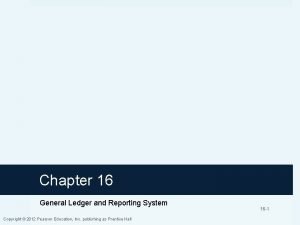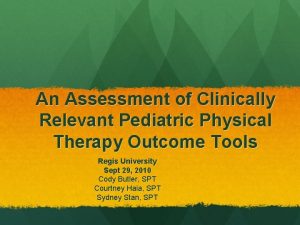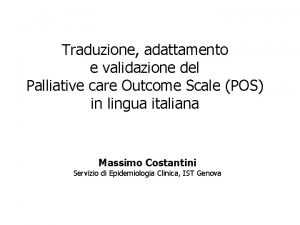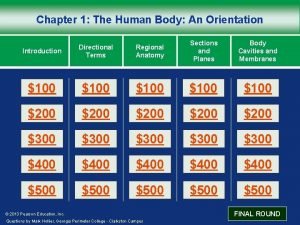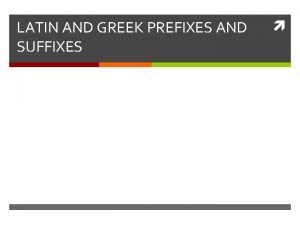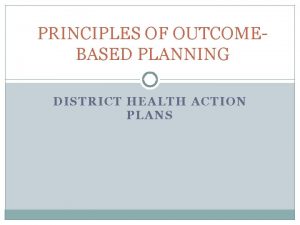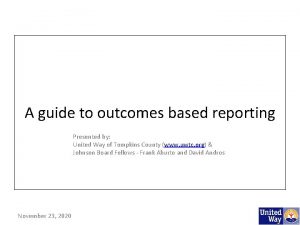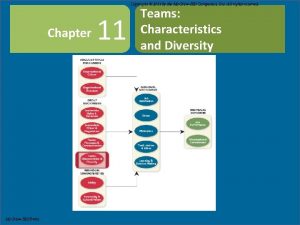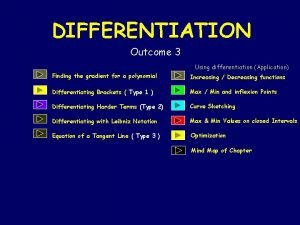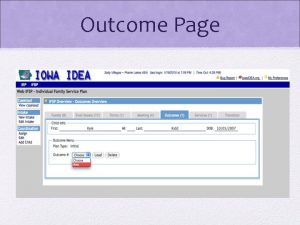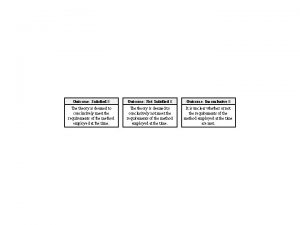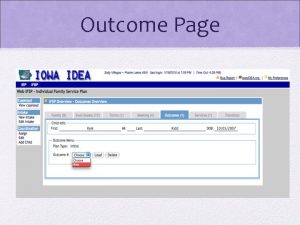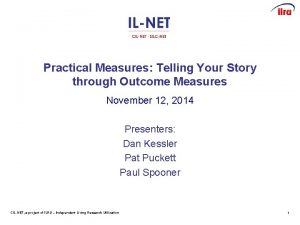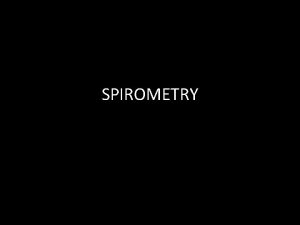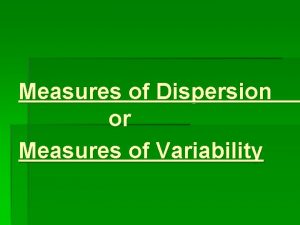A trial of outcome measures reports designed specifically


























- Slides: 26

A trial of outcome measures reports designed specifically for consumers Tom Trauer Glenda Pedwell St Vincent’s Mental Health Service, Melbourne 1

Background Increasing consumer expectations for access to information has been a growing trend in health Outcome measures are a rich source of information for potential use by consumers and clinicians But access to information has rarely be driven by treatment providers and has more typically been driven by consumer demand Increasing the expectations of consumers the outcome measures be used to track their treatment and progress over time is a by-product of this study 2

Background Completion statistics and anecdotal reports indicate that • consumer-completed outcome measures are infrequently offered, and • outcome measure results are infrequently shared with consumers This may account in some degree to the variable uptake of outcome measures 3

Aims 1. To design an outcome measure report more suited to consumer purposes 2. To trial this report in routine clinical practice within several clinical teams 4

Background All current outcome measure outputs have been designed with clinicians in mind 5

Standard report (Victoria) 6

Standard report (Queensland) 7

The new report Reduce the information presented to the essentials Organize the information in a different way Move away from the traditional Ho. NOS and LSP ordering of the items Arrange the information according to areas of no problem, some problem, big problem 8

New report – the Ho. NOS 9

If both the Ho. NOS and the LSP are available, they will appear on the same page 10

This is the Behaviour and Symptom Identification Scale (BASIS), the consumer self-rating scale used in certain Australian states. It comprises 32 items, rated • • • No difficulty A little difficulty Moderate difficulty Quite a bit of difficulty Extreme difficulty 11

Trialling the new report We aimed to recruit two adult mental health teams (in the end we only got one) We negotiated with the managers and clinicians to ensure that the reports on consumers assessed were placed in their pigeon-holes We asked clinicians to offer the reports to the consumers that they saw We attended the weekly team meetings and asked about the use of the reports 12

Results Low uptake; most clinicians didn’t do it, and a few discussed the reports with consumers only a few times We list themes under several headings 13

Potentially adverse effects on consumers Listing a consumer’s problems could have a demoralizing effect “The BASIS – it can stir things up” Results not shared because the consumer was not in a good mood that day “If you push her too hard she may disintegrate” “It has a vaguely big brother feel about it – being analysed and judged – it can raise paranoia” 14

Damage therapeutic relationship “The client is very low functioning and grandiose – so there is a maximum discrepancy and it would damage the relationship” 15

Time pressures “It might take a bit longer to explain to a consumer why we are doing outcome measures” “It just seems like such a hard thing to do as well as everything else – if the caseload was smaller it could be more possible” “I just haven’t had time” 16

Perceived irrelevance to some consumers BASIS not offered because “he feels that he doesn’t have any problems” “The vast majority of mine [consumers] have negative symptoms and are poor responders” 17

Harder to give bad news than good news One clinician said that it would be easier to share results that indicated improvement than results that indicated no improvement or worsening “It is easier if patient improving rather than going backwards” 18

Differing opinions could cause friction (Clinician had rated the consumer on the LSP as having a problem in showing warmth) “Consumer said ‘What do you mean I don’t show any warmth? !’ it made relationship more rocky” 19

Self-rating too hard for some consumers “I had someone refuse the BASIS – too many questions on it” 20

Form-phobia “Some patients just hate seeing a typed form that is about them” “With the ratings it looks like a test – like being at school” 21

Having to share ratings may affect them One clinician said that knowing they would have to share their assessments with consumers might lead them to rate more leniently 22

Difficult to discuss another clinician’s ratings One clinician said that discussing another clinician’s rating with a consumer could be difficult, especially if one didn’t agree with them, or if they were no longer applicable 23

Positive comments “Has been of benefit – has been a way of opening up some issues” “I gave him a BASIS when I discussed the Ho. NOS and LSP – he brought it back completed – it helped that process” (ie talking about Ho. NOS and LSP helped process of BASIS completion) 24

Conclusions While suitably designed reports may be helpful, they are not sufficient to ensure maximum use of outcome measures Discussing the difficulties that clinicians have in using outcome measures with consumers can reveal obstacles Team culture is important; in the team studied there was little expectation of use of outcome measures by either clinicians or the managers 25

Implications The current study needs to be repeated in other teams, including different age groups Training in outcome measurement should include development of skills in sharing results with consumers. Suitable materials for this exist, and are being used in some jurisdictions Consumer representatives can advocate for consumers to be routinely provided with the results of their measures More broadly, outcome measures should be conceived as belonging as much to the consumers as to the providers 26
 The basic activities in the glars are
The basic activities in the glars are How do informational reports and analytical reports differ
How do informational reports and analytical reports differ Pediatric physical therapy assessment tools
Pediatric physical therapy assessment tools Outcome measures traduzione
Outcome measures traduzione A broken hallux refers specifically to a broken
A broken hallux refers specifically to a broken Repeated measures design
Repeated measures design Outcome synonm
Outcome synonm Outcome based assessment in ecd
Outcome based assessment in ecd Kaitlyn platt
Kaitlyn platt Predict the outcome
Predict the outcome The renaissance outcome the renaissance in italy
The renaissance outcome the renaissance in italy Japan during the age of exploration
Japan during the age of exploration Outcome based accountability
Outcome based accountability Outcome based planning
Outcome based planning The reformation outcome: martin luther and the reformation
The reformation outcome: martin luther and the reformation Outcome based reporting
Outcome based reporting The age of exploration outcome the atlantic slave trade
The age of exploration outcome the atlantic slave trade Learning outcome of poem
Learning outcome of poem Outcome interdependence
Outcome interdependence Teaching tolerance
Teaching tolerance A government-created monopoly arises when
A government-created monopoly arises when Differentiation by outcome
Differentiation by outcome Outcome based massage
Outcome based massage The middle ages outcome the power of the church
The middle ages outcome the power of the church Expected outcome example
Expected outcome example The renaissance outcome renaissance painters/sculptors
The renaissance outcome renaissance painters/sculptors Pico patient
Pico patient
